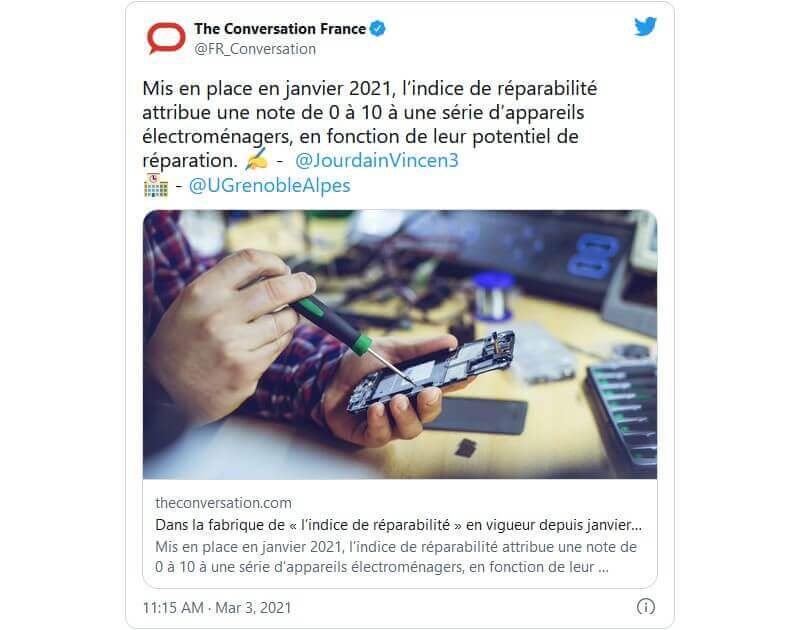In two studies unveiled on January 19, 2022, the Ecological Transition Agency (Ademe) looks at digital technology and its effects on the environment in France. The first, carried out jointly with Arcep, draws up an inventory of the impact of digital services in France, taking into account all the elements necessary for the construction of a digital service: networks and infrastructure, data centers, equipment users in individuals and businesses (smartphones, connected televisions, connected objects).
Among the lessons of this systemic work, one aspect stands out: manufacturing is the stage of the life cycle with the greatest environmental impact. And the “terminals” part (ie our digital devices) is by far the most striking part. Hence the interest of the second study, which consists precisely in measuring the environmental benefits generated by the reconditioning of equipment – work carried out initially on smartphones and which will be followed by other categories of electronic equipment.
In these two approaches, Ademe has chosen a life cycle approach, which makes it possible to measure the environmental footprint from the extraction of material until the end of the product’s life. The work also focuses not only on the “climate change” indicators but also on the depletion of natural resources, the material footprint and energy consumption.
Digital, 2.5% of France’s carbon footprint
Several telling figures mentioned in these works deserve to be underlined, each time expressed over one year of use.
Firstly, France’s carbon footprint – direct and indirect greenhouse gas emissions – due to digital services represents, over one year, 16.9 million tonnes eqCO2. This equates to 2.5% of France’s total carbon footprint and is approximately the same footprint as the waste sector.
In terms of the exploitation of natural resources, the digital footprint corresponds over one year to the equivalent of the extraction of 21 tonnes of gold.
The sector also produces 20 million tonnes of waste per year, mainly generated by the exploitation of natural resources and production – waste not to be confused with waste directly generated by equipment, included in this volume.
Finally, the share of digital in French electricity consumption amounts to 10%, with a volume of 48.7 TWh. Per inhabitant and per year, these various impacts represent 253 kg eqCO2, 300 kg of waste produced and nearly 1 ton of materials moved.
Our terminals, 60 to 90% of the digital footprint
This extensive work, never carried out in such a successful manner in France, makes it possible to identify that the subject of digital technology is not reduced to the sole issue of climate change and that the majority of the impact is at the level of terminals, that is, devices that we use on a daily basis.
Depending on the environmental indicators considered, these are responsible for 60 to 90% of the impact of digital, while the remaining 10 to 40% are attributable to fixed and mobile networks as well as data centers. If we take the example of the depletion of resources (materials), we see that 90% of the digital footprint in this area comes from our fixed and mobile terminals.

Let us now consider the life cycle: the work of Ademe reveals that the environmental impact of the manufacturing stage is very largely predominant throughout the entire life cycle.
These are all elements that emphasize the need to extend the useful life of our equipment. Among other things, through the purchase of reconditioned objects.
The benefits of refurbishment
To measure the environmental benefits of reconditioning, Ademe collaborated with all of the sector’s stakeholders in France. It initially focused on the smartphone, other results will come later on other equipment (computers, tablets and game consoles).
Several interesting figures emerge, which constitute variable averages according to certain criteria, such as the duration of use of the product prior to its reconditioning as well as the conditions of this reconditioning.

On average, the acquisition of a refurbished smartphone would thus reduce the annual environmental impact by 77% to 91% compared to a new purchase, depending on the indicators. On the “climate change” footprint, in particular, the impact drops by 87%. This choice also avoids the extraction of 82 kg of raw materials and the emissions of 23 kg of greenhouse gases over one year per refurbished smartphone (versus new).
The longer the reconditioned device is used, the greater the savings in materials and greenhouse gases – provided that the reconditioned device is replaced by a new one.
An imperfect but always winning choice
It should be emphasized that we have not sought in this study either to minimize or to maximize the environmental benefit, since we have taken into account cases where key parts such as the screen and the battery were changed: even in these cases and there including when new accessories are included in the sale – charger and headphones, which is often the case – the environmental impact remains more than 2 to 4 times lower than in the production of new equipment. And this, even when the reconditioning is carried out abroad, in countries of the East or in China, for example.
Taking into account these elements and the preponderant place of the manufacturing phase in the environmental impact of digital technology, it seems essential to limit over-equipment, to extend the life of devices as much as possible, by maintaining them, by having it repaired and turning to second-hand or reconditioning when it is changed, the latter option offering guarantees of operation.
Good practices for optimal reconditioning
Since reconditioning is not free of impacts, it is preferable for consumers to favor products from local reconditioning and to avoid reconditioned models that are too recent in order to encourage the logic of extending use. .
On the refurbisher side, there are several ways to improve the footprint of their practice: try to collect used telephones locally, favor second-hand spare parts, suggest that the customer does not systematically supply new accessories and deploy repair workshops in France rather than abroad.

But it is also a question of professionalizing the reconditioning. First by offering a quality service approach with good after-sales service in order to give customers confidence in the purchase of reconditioned equipment.
Also by optimizing processes, developing innovation, automating certain tasks in order to achieve economies of scale and, in turn, lower prices in order to make the price difference between new and refurbished more attractive. Finally, by reducing the reconditioning site’s energy and water consumption, which weighs heavily on the latter’s footprint.
This analysis was written by Raphaël Guastavi, head of the “Products and Material Efficiency” department of the Ecological Transition Agency (Ademe).
The original article was published on the site of The Conversation.




:quality(75)/cloudfront-us-east-1.images.arcpublishing.com/elcomercio/LVQPFE7VF5BJ5HW5S4XZIS4BSA.jpg)
:quality(75)/cloudfront-us-east-1.images.arcpublishing.com/elcomercio/HJA5EX64FBEYDEQE5W6PMPUHPY.jpg)
:quality(75)/cloudfront-us-east-1.images.arcpublishing.com/elcomercio/CSZQI2XX2FFAHH7O6MGZ3NOL64.png)
:quality(75)/cloudfront-us-east-1.images.arcpublishing.com/elcomercio/O3QRAPJ54RC2RLB4OTDKEVN2I4.jpg)
